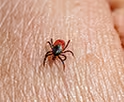Bubonic Plague Reappears: Symptoms, Causes and What You Need to Know
The Resurgence of Bubonic Plague: What Is This Disease?
Reading time : 1 minute,
Discovery Chepe Id-783-SAL
Published in
07-14-2025

Photo: CDC
The bubonic plague is a serious infectious disease caused by the bacterium Yersinia pestis. It primarily affects rodents but can be transmitted to humans through the bite of infected fleas. Historically, it has been one of the deadliest diseases ever recorded.
A Brief History of the Plague
The most infamous outbreak of bubonic plague occurred during the 14th century and is known as the Black Death. This pandemic killed an estimated 25 to 50 million people in Europe alone, wiping out nearly a third of the continent's population. However, the disease has appeared in several waves throughout history:
1- The Plague of Justinian: In the 6th century, it devastated the Byzantine Empire.
2- The Black Death: The 14th century pandemic that changed European history.
3- The Third Pandemic: In the late 19th and early 20th centuries, it spread from China to other parts of the world.
Today, thanks to antibiotics and improved hygiene, the plague is treatable and much less deadly when diagnosed early.
Symptoms of Bubonic Plague
The plague manifests itself in different forms, but the most common is the bubonic type. Here are the primary symptoms:
a) Fever and chills: A sudden rise in body temperature.
b) Painful and swollen lymph nodes: Known as 'buboes,' typically appearing in the groin, armpit, or neck.
c) Fatigue and weakness: A general sense of exhaustion.
d) Muscle pain and headache: Common signs of infection.
If untreated, the infection can spread to the blood (septicemic plague) or lungs (pneumonic plague), both of which are more dangerous and can be fatal.

Is Bubonic Plague Back? Essential Information on the Disease
Photo: CDC
How Is It Transmitted?
The bacterium Yersinia pestis is usually transmitted through flea bites that have fed on infected rodents like rats, squirrels, or prairie dogs. However, in rare cases, it can spread through direct contact with contaminated tissues or inhaling infectious droplets in cases of pneumonic plague.
Prevention Measures
Even though cases are rare, some precautions are essential, especially in regions where plague persists in wild rodents:
1- Avoid contact with wild rodents and their habitats.
2- Use insect repellents to prevent flea bites.
3- Keep pets free of fleas and prevent them from hunting wild animals.
4- Report dead animals to local health authorities.
5- Seek medical attention immediately if you develop symptoms after exposure.
Is There a Treatment?
Yes, the plague is treatable with antibiotics such as streptomycin, gentamicin, doxycycline, or ciprofloxacin. The key is early diagnosis and treatment to avoid complications or death.
Recent Cases and Public Health
Although it might surprise many, the plague is still present in certain parts of the world, including the United States, particularly in the Southwest. According to the CDC, around 7 cases of plague are reported annually in the U.S.
In July 2025, a man from Coconino County, Arizona, died from pneumonic plague, a reminder that the disease, though rare, is still among us. Health authorities have emphasized that the risk to the general public remains low, but vigilance is necessary.
For more official information, you can visit the World Health Organization or the Centers for Disease Control and Prevention (CDC).
The bubonic plague is no longer the unstoppable killer it was in the Middle Ages, but it hasn't disappeared entirely. Thanks to modern medicine, most cases are treatable, and prevention strategies are well-known. Knowing the symptoms, transmission, and prevention can make a significant difference in containing any outbreak and saving lives.
Stay informed and cautious, especially if you live or travel to areas where the plague is still endemic.
See Also
Discovery Chepe
Most read...















